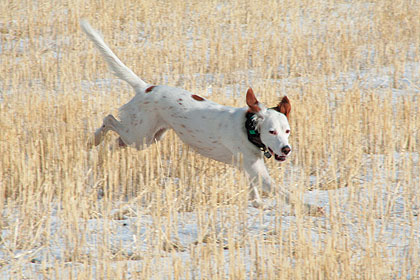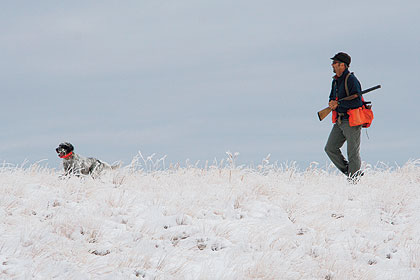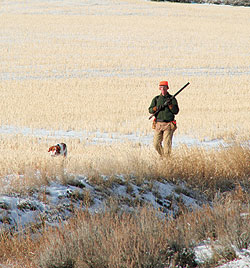Cold-weather problems run the gamut from annoying to life-threatening.
By Dave Carty
It had been blazing hot for mid-October -- in the 80s. But opening day of the Montana pheasant season dawned with temperatures in the 30s and three inches of new, wet snow on the ground. Within half an hour, my friend Russ' little setter, Sassy, was in trouble.
 A hard-running dog exhales tremendous amounts of moisture, so keeping your dog well-hydrated during the hunt is critically important. |
She'd begun shivering soon after the hunt began, after the snow-soaked grass had drenched her to the skin. By the time Russ realized the shape she was in, she'd disappeared. He finally found her burrowed into a ball under some sagebrush, trying instinctively to warm her rapidly cooling core. Russ wrapped her in his coat, picked her up, and began a long, desperate run back to his truck.
Halfway back, fording a waist-deep stream, she slipped from his arms and went bobbing down the current. When he caught up with her, she was almost gone. She was unconscious when he reached the truck.
Furiously, he toweled her off, then turned on his heaters full blast and placed her limp form beneath them. And then, slowly, miraculously, she came around. Unbelievably, an hour later she was fine.
Sassy was one lucky buckaroo.
All of us know that dogs handle cold much better than heat, but it's important to understand that cold weather brings with it its own set of problems.
The most serious of those is hypothermia. "Where I've seen it most are dogs like German shorthaired pointers, English pointers, wirehairs," says Dr. Arleigh Reynolds, an Alaskan sled-dog racer, veterinarian, and senior scientist at Purina. "Those guys, they're so high-rev that they'll burn up what fuel they have because they have such strong prey drives. So you have a dog that's a little low on fuel, doesn't have a lot of insulation, and then you put that dog out in a situation where it's wet and windy, and the temperature is dropping€¦ that dog is gonna be at risk."
If wet, cold and windy sounds like where you hunt, welcome to a not particularly exclusive club whose members live north of the Mason Dixon line. Geography, however, is no excuse for letting your dog suffer from exposure. And two of the best things you can do to prevent it is to keep him well fed and well hydrated. Sounds strange, doesn't it?
My dogs, and I'll bet yours too, almost never want food or water when it's cold.
Bob West, a decades-long dog trainer also with Purina, knows firsthand how difficult it can be to get a cold dog to drink. So he gets water into them any way he can.
"The way I try to keep my dogs hydrated in the winter is, I take their food portion, put it in a bowl, and then put in enough water to float it," he says. "That forces them to drink the water to get the food." West, like most of you, keeps water handy in the field, in a squirt bottle he keeps inside his vest where it won't freeze.
"You can actually just bring the dog in, hold their head up, and squirt a little in their mouth where they'll have to swallow," he says. (Dave's disclaimer: This is not something I do, but after talking to West and Reynolds, it's certainly something I'm going to try.)
 Most gun dogs can handle cold better than heat, but winter presents its own set of challenges and hunters need to monitor conditions carefully. |
Next in the you-probably-didn't-know-this category is that cold weather dramatically increases a dog's need for digestible energy. That means food, and that probably means more than you've been feeding. West told me a dog's increased needs can be dramatic.
"You can figure, roughly, a six percent increase in caloric needs for every 10-degree drop in temperature," he says. "If you figure it's down around 10 degrees and you're working your dog fairly hard as compared to a dog in the summer at rest, you can double his caloric needs."
How do you get that kind of fuel into a dog? Two ways: feed the dog a food with a higher fat content, or increase the dog's supply of the food it's already getting. Since it takes eight to 12 weeks for a dog to fully assimilate a switch to new food, West favors the latter, selecting a good food and simply monitoring the dog's intake -- less during the off season, more when it's cold and the dog is hunting hard.
The amount of moisture that winter air can suck out of a dog is amazing. "The problem is, the air is very dry when it's cold out," Reynolds says. "Your dog is inhaling air that has virtually no moisture in it and exhaling air that is 100 percent saturated. If they're running hard, they can lose more water in their breath than they do in their urine.
"That's a significant amount of water loss. So what we do is, morning and evening, give our dogs something we call baited water. All that is, is water mixed with a little dog food -- I've even used canned cat food -- mixed with the water to make it real flavorful so they'll drink it right when you put it down, because the other problem with cold weather is that the water freezes, so you can't just leave it out.
"Dogs," he says, "will learn how to do that. It actually doesn't take very long to do that, and if you teach them to drink (either baited water, or from a squirt bottle, which West favors) when you're doing your summer conditioning, it will carry over well into the winter."
Reynolds also recommends giving a working dog a small amount of water -- maybe an ounce or two -- every 15 or 20 minutes for the duration of the hunt. During that same hunt, he also suggests giving it several very small feedings (not a full meal) of dog food. The reason? The digestion process raises the dog's temperature. Chalk that one up to something else I didn't know canine plumbing.
 Frigid temperatures combined with wind and/or wet conditions can become life-threatening to a hard-working gun dog. |
Keeping a dog well fed and hydrated is critical to its ability to fight off hypothermia, but even the b
est conditioned dog can run into weather it just isn't equipped to handle. Cold weather is bad, wind is worse, and wet is worse still. Put the three together, and while you certainly shouldn't stop your hunt, you'd do well to keep a close eye on your dog.
Most of the pointing breeds, unlike retrievers, aren't equipped with two-layer coats or much in the way of subcutaneous fat, so when they're wet and tired, a cold breeze can suck the heat right out of them, as my buddy Russ learned. Watch for uncontrollable shivering. If the dog becomes lethargic or starts stumbling, you need to warm him up fast, anyway you can.
Fortunately, most of us will never have to deal with hypothermia in a well-conditioned dog. But cold weather causes other problems, too, most more annoying than life threatening, and most of those are due to one thing: snow.
Believe it or not, I happen to enjoy hunting in snow, but when it's deep and wet, the stuff can pack between my dog's toes and cause endless problems — discomfort for the dog and aggravation for me. Some dogs, like one of my setters, simply ignore it. Other dogs, like my Brittany, will stop dead in their tracks to chew their feet. My Brittany is so bothered by her icy toes, in fact, that on some days she stops hunting all together.
I've tried everything I can think of to prevent the problem, from shaving the hair between her toes to coating them with Vaseline, and only one thing has ever worked: dog boots.
They're a pain to put on, and I know the dogs dislike them, but if I'm going to be hunting in deep, wet snow, the boots I keep in the back of my truck will probably see some use.
Icy toes aren't a problem on the same order of magnitude as hypothermia, but believe me, they can kill a hunt almost as quickly if you've got a foot-sensitive dog.
Finally, let me climb on my soapbox for a moment. I really hope you're not one of the guys who puts your dog in an open crate in the open bed of your pickup in the winter, but if you are, march right down to your pet store and buy an insulated cover for it (and remember to keep one corner unzipped for ventilation). I can't imagine anything more miserable for a dog who has spent all day hunting his heart out in cold, icy weather than to be stuck in an open crate for the ride home, with nothing to keep him warm and nowhere to hide from the frigid wind.
If nothing else, you'll provide him a head start on the warmth and rest he's going to need to hunt for you tomorrow. After all, he just finished giving you 100 percent. You can return the favor by giving him what he needs and craves: a warm, comfortable ride home.






